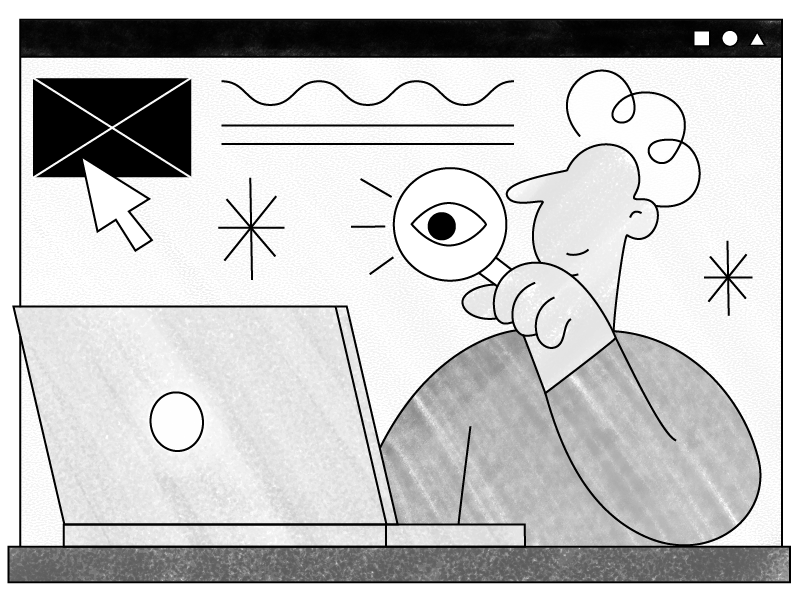No matter if you are a freelancer, or an agency owner, one thing is for sure: the market you are operating in is overly saturated with competition. There is always someone after your job, chasing the same clients you are.
And that can be considered bad news.
The good news is there are many ways you can differentiate yourself from the competition: create an impressive portfolio website, highlight testimonials on that same website, be an active member of your community, be present on social media, post your work on industry-related platforms, etc.
The only problem with these steps is that they require constant work. You have to work continually on building your online image, and showing off your skills, experience and knowledge. This means that once you are done with work, you need to spare at least an hour or two of your free time to promote yourself online. And that sounds exhausting.
But what if we told you there is a one-and-done solution that could get you the respect and the clients you need? Would you be interested in trying it out?
It’s adding business case studies on your website.
According to HubSpot’s Report 2022, case studies are the fifth media format marketers use. They come after videos, blogs, images, and infographics. Although case studies seem like an outdated content strategy, they are still alive and kickin’, and we believe you should include them on your portfolio website.
In this article, we will list all the reasons why it is essential you add business case studies to your website. We will also give you tips on writing compelling case studies your potential clients will enjoy reading. Let’s get started!
But first, what is a case study?
A case study is a well-developed study that explains a request you or your business received from a client and the steps and processes you took to meet that request.
It should be a thorough, compelling essay that explains who your client is, what the client’s problem was, and the solution you provided that suited the client’s goals the best. The case study should demonstrate your skills and concrete results your solution provided.
A case study is there to showcase your work and frame it in the context of helping clients.
Why should you include business case studies on your website?
There are many reasons why you should include case studies on your website:
You will show how skillful and operative you are.
If you offer multiple services to clients on your website (like building a brand identity, rebranding established businesses, creating branding strategy, formulating brand guidelines, etc.), you might not have enough room on your site to explain the process and the steps behind each and every service. And business case studies can help.
A case study allows you to explain the steps that go behind each service and how your skills and knowledge can help clients reach their goals. So, for example, if you are a freelance developer and you recently built an e-commerce website for a client, you can list all of the steps of website development (and there are many!): gathering information from the client, creating structure, designing the website, coding, testing, launching and everything in between. Once you do, you can explain each small step that goes into the previously defined stages. You can even explain how long each step takes you to complete, how you tailored the steps to meet a client’s needs, etc.
You will show just how flexible and experienced you are.
If you have partnered with clients before, you know that you need to tailor your service to each client. Business case studies are a great way for you to show just how flexible you are when it comes to the services you provide. It can also show (excellent) communication skills and problem-solving strategies you have up your sleeve.
You will build a reputation and establish brand authority.
It may seem strange that you can build a good reputation just by posting business case studies on your website but remember that the studies serve as examples of how you work with clients. They reflect your work ethics一whether you listen to clients, if you are ready to go to the nitty-gritty details about the problem they are facing, whether you are respectful to them, prepared to answer their questions and give new ideas, etc.
If you use case studies to show just how helpful and in touch you can be with clients, you will be perceived as professional, and potential clients will be excited to work with you.
You will show that your work gives impressive results.
Your potential clients know that talk is cheap. You can do your best to persuade them that your business is ‘legit’ with a professional website, big fish clients, and good reviews or testimonials. But your business is doomed if you don’t have concise results demonstrating that what you are selling is the truth. That’s why we highly recommend you use business case studies to explain the solution you have come up with for your clients and quantify how the solution helped the clients’ businesses.
Ultimately, you will attract new clients.
You have to admit it: thousands of professionals and businesses offer similar services to you. Sure, they are different from you per se, but they market the same service (and most likely, in a similar way) as you.
That’s why clients research businesses/freelancers they are considering partnering with. They read Google reviews, check their social media handles, and visit their websites. And a well-designed website with crazy-looking animations and contemporary typography might move them closer to choosing you, but what will ‘seal the deal’ is your willingness to be their right hand; your desire to be in the line of fire with them. And the only thing that can show that you are happy to get your hands dirty is case studies.
Now that you know why you need to include business case studies on your portfolio website, let’s move on to how you can write compelling, well-rounded case studies that will help you get hired by top-tier clients.
Here are a few tips to help you:
Tip #1 一 When outlining the case study, consider it a high school essay.
Sometimes the most challenging thing you can do is to take the first step: sit down and start writing a case study. And if you are not much of a writer, you’ll need some time to get the hang of it.
To help you overcome the fear of writing a business case study, we advise you to consider it a high school essay.
Back in high school, every paper you wrote had to consist of three basic sections一introduction, body, and conclusion. And a case study is the same. When it comes to introduction, it’s important you include a hook, to lure potential clients in and encourage them to want to learn more. The body should provide insight into how you operate with clients. In the end, you need to formulate a killer conclusion, filled with concise data and results that show the success of the company you partnered with.
If you are still having trouble outlining the structure of the case study, we suggest you focus on a conflict and a resolution. The conflict is an issue the client needs your help to be solved, and a resolution is a product or service you came up with. So, focus on these two things: the challenges the client was facing, why they came to you for help, and how your business solved those challenges using different techniques, knowledge, experience, etc.
Tip #2 一 Know for whom you are writing the case study.
As with anything in marketing, it always starts with defining the target audience you want to attract. From everything that has been said before, we can agree that your target audience is future clients. But you have to be more specific than that. What demographics do they belong to? How large companies are you targeting? What industry are you targeting? Are you looking to partner with startups or well-established brands?
You must answer all the questions to determine the tone and voice you’ll use throughout the case study.
Tip #3 一 Choose the right tone and voice.
Once you know for whom you are writing the business case study, you can adjust your tone and voice.
The tone of the case study must fully adjust to the clients you are interested in partnering with. So, for example, if you are trying to get hired by Adidas to create a new logo (what an honor that would be!), you can write a business case study about, let’s say, redesigning Nivea’s old logo. You can do so by writing something like “I drew a round logo, and made a few new packaging designs. The company immediately liked it, and it improved sales worldwide.” But you have to admit that the two sentences didn’t explain much一not your design process, not the research you put into creating the new logo, nor the results.
You would sound much more professional if you wrote “Inspired by the established brand values, I have developed a round logo, which reflects the famous Nivea tin packaging. The goal was to decrease the time consumers spent finding Nivea products in stores. The new logo packaging reached the goal, as, in the period of six months, sales increased 34% worldwide.” Sounds much more professional and polished, doesn’t it?
Now, the voice.
The voice you use in a case study is actually the technical part of writing. The writing style should be informative, and the text should be clear, concise, and grammatically correct.
Bonus tip: Be sure not to use industry jargon when writing a business case study. If you do, you’ll make the case study hard to read, and clients won’t bother reading something they could not understand.
Tip #4 一 Provide background information about the client.
Before you introduce a client’s problem, you need to share information about the client.
No matter if you have partnered with small businesses or were hired by Apple, you are obligated to mention your client’s name and background information in the case study. So, right after the introduction, mention the client information in 5-10 sentences. You can explain more about the company’s products or services if the client is not that well-known.
Bonus tip: If you don’t know what to write about a client, base that section of the text on the words used on their company website or LinkedIn profile.
Tip #5 一 Explain in detail the client’s issue and the project’s goals.
Once you have introduced the client, you can move on to explaining the goals of the project and what the client’s problem was. Don’t hesitate to be as thorough as possible when describing the client’s wants and needs from the project. By doing so, potential clients will see that you are interested in understanding the project and the client’s pain points.
Tip #6 一 Explain your role in the project and the solution.
Once you have introduced the client and explained the issue they have been facing, you can switch the focus of the case study to you一it’s time to highlight your role in the project. How did you help the client? What was your main role? Have you, perhaps, had multiple roles? Be sure to explain your roles and responsibilities as detailed as possible; you can even list all the tasks and duties.
Bonus tip: At this stage, you can mention how long it took to complete particular tasks and whether there were a few iterations regarding specific tasks or challenges.
Once your role is clear, you can explain the solution you came up with. Feel free to share how your products or services helped solve the client’s issue. Get into the specifics, and don’t forget to mention the decision-making throughout the process.
Tip #7 一 Mention your teammates.
If a client decides to hire more individuals from various companies for you to work with, you have to be a respectful professional and mention your teammates in that project. However, if there were more than 20 or 30 people involved, you don’t have to name them all一just mention who the client was and that there were multiple people involved.
Tip #8 一 Use accurate data.
At the very end of the case study, it is necessary to highlight exactly how you have helped the client, that is, what the results of your partnership were.
For this particular section, we advise you to use actual data and not embellish the results or arrange them in a way that can be misleading or deceiving. Using real data in your case study not only builds trust with potential clients but will demonstrate that success can be quantified. It also gives potential clients hope that success cannot just be quantified but is also reachable and just a few steps away. And all they need to do to reach that success is hire you.
Bonus tip: Real data can show how much you’ve helped a client, but there’s nothing quite like hearing it from the client’s mouth. To boost your credibility, you can include a quote or testimonial from the client in the case study. If you decide to have it, keep it short and sweet. It can be written in one or two sentences一long enough to illustrate the client’s satisfaction with your work.
Tip #9 一 Once you are done writing it, proofread it.
We can’t highlight enough how essential it is to proofread the case study. You need to make sure that the text is free of errors in style, word choice, tone, grammar, and spelling.
Once you are sure that the case study is error-free, we suggest you pay attention to one more thing: the storytelling nature of the case study format.
As you know, a case study allows you to tell a story about other brands (you have partnered with) and your own, making it an effective sales tool. So, make sure that the text has a flow and that it paints a picture, and stimulates positive emotions. This will give the case study an even greater selling power.
Tip #10 一 Promote your business case studies.
Our final tip has nothing to do with writing a case study but publishing and promotion.
Publishing a business case study doesn’t have to be the end for that case study; you can also promote it on other channels, to boost your credibility, and share your expertise with your peers.
When promoting a case study, we advise you to choose the right platform based on your industry. So, for example, if you are a marketer, you might want to publish it on your LinkedIn profile. If you are a graphic designer, you should post stunning visuals of the work you included in the case study to Dribbble and Behance and link them to the case study. See what we mean?
Bonus tip: If you need some visual inspiration to create your case study, we suggest you look at these 19 examples of case studies done right.
Final thoughts
As you had a chance to see, adding business case studies to your website is a fruitful marketing tactic that doesn’t require much of your time or money. It can help you boost credibility and get more clients fast.
Now that you know just how important case studies can be for your business and career, will you include them in your portfolio website? Let us know in the comments.



